As we experience more intense storms in Pittsburgh, we see more frequent sewer overflows and floods. Floods impact all of our lives, and we all have a shared responsibility to prepare for floods.
PWSA is addressing our city’s stormwater management system so that we have strong, safe, healthy, flood-prepared neighborhoods. Our goal is to better manage stormwater so that it doesn’t overwhelm the capacity of the sewers during storms – so when it rains, we don't have basements backing up with raw sewage (putting families’ health at risk), pollution flowing into our rivers, or flooded roads.
We encourage residents and property owners to take measures to protect their homes, buildings, and belongings from flooding. Every Pittsburgher needs to learn about and practice flood safety, especially since flash floods can occur with little to no warning.
Common Types of Flooding in Pittsburgh
Stream and River Flooding
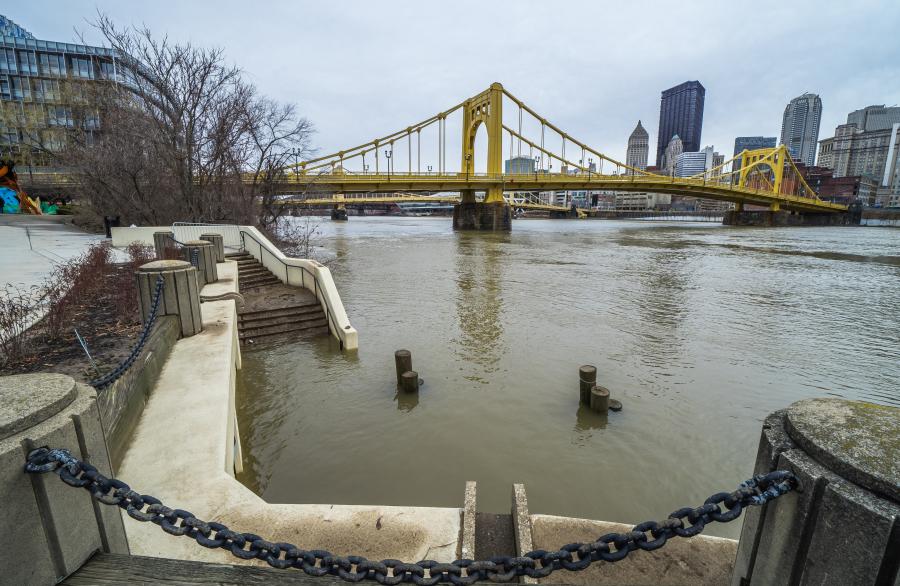
Streams and rivers flood when rainfall or snowmelt causes water levels to rise up over the top of the channel's banks.
The floodwaters flow onto the floodplain, an area of low-lying land next to a stream or river. If the flood is large, water levels can even spill over onto land higher than the floodplain.
Streams and rivers flood naturally, which means that any properties built within a floodplain are at a high risk of flooding.
If you see any stream or river nearing flood stage, flooding, or blocked with ice jams, please report the occurrence to the National Weather Service (NWS) Pittsburgh using their webform, phone recording system, Facebook, or Twitter.
You can help reduce stream and river flooding by never dumping yard waste or other debris into a stream or river. This debris can block the channel and make floods worse. Learn more on our Help Manage Stormwater page.
Overland Flooding
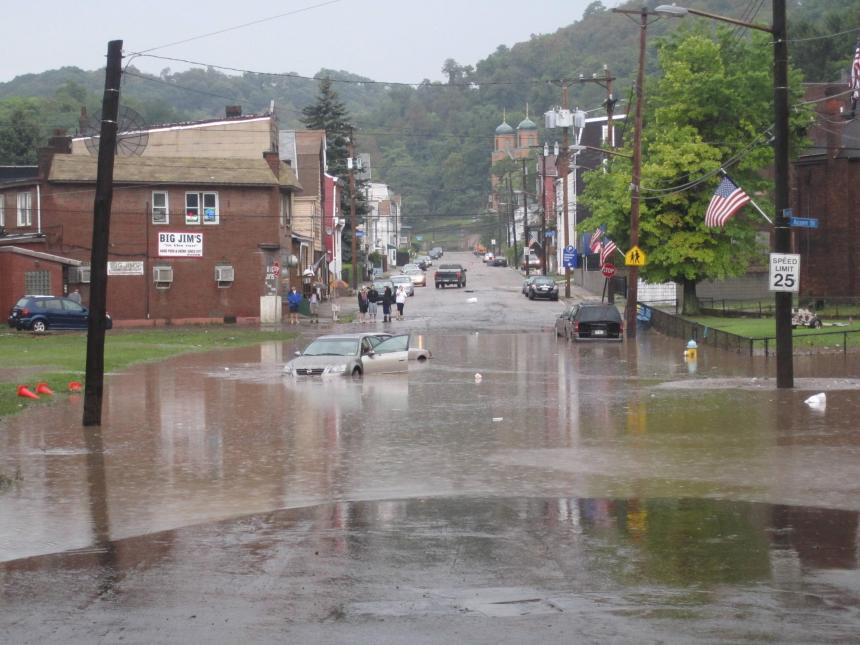
Overland flooding occurs when water runs across the land after excessive rainfall or snowmelt, covering areas that may not even be near a stream or river.
These floodwaters can quickly submerge roads and sidewalks, causing hazards for vehicular traffic and pedestrians. Rising floodwaters can damage the outside and inside of buildings. Stormwater can even leak through gaps in the foundation, doors, and windows to flood basements.
If you see any street or basement flooding during storms, please report the occurrence to the National Weather Service (NWS) Pittsburgh using their webform, phone recording system, Facebook, or Twitter.
You can help reduce overland flooding by keeping storm drain grates free of litter, leaves, and other debris. Learn about more actions you can take on our Help Manage Stormwater page.
Sewage Backups
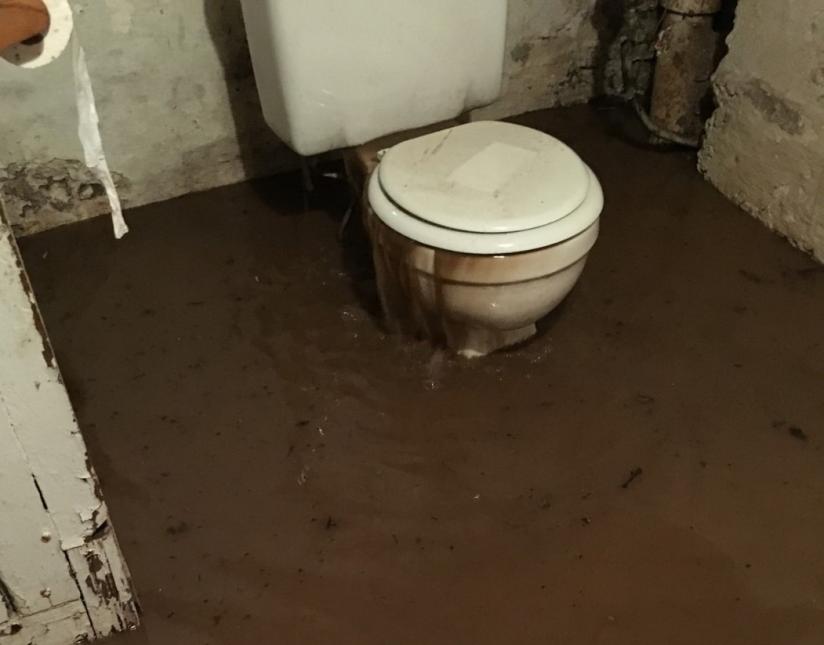
Sewage backups occur when a private or public sewer system is blocked, broken, or overwhelmed by heavy rainfall or snowmelt.
- Blockages can be caused by grease, hair, wipes, and other solid material buildups in the pipes including concrete.
- Tree roots can also block and crack sewer pipes.
- Some portions of our public sewer system don't have the capacity to handle heavy rainfall or snowmelt, which causes stormwater and sewage to overflow into the rivers and backup in the system.
Sewage contains bacteria, viruses, and other pathogens that can be harmful to your health and can contaminate the area in which the backup occurred (often the basement). Accidental ingestion or contact with raw sewage can cause gastrointestinal illness, skin infections, or rashes. It is important to stay away from the contaminated area until professionals can come to assess the damage.
If you see sewage pooling in your home, please immediately call our 24/7 Emergency Dispatch at 412-255-2423 (Press 1). We will dispatch a crew to assess the situation, which includes determining if the problem is with the sewer main or with the sewer lateral.
- If it is a broken or clogged sewer main, we are responsible.
- If it is a broken or clogged sewer lateral, the property owner is responsible.
- The property owner is also responsible for cleanup if the sewage backup occurred during a period of heavy rain that then drains once the storm event comes to an end. The backup was caused by a greater volume of water entering the combined sewer system. Once the problem is corrected and the sewage has drained from your property, you can begin cleaning up. Learn more about preventing and cleaning up sewage backups on our Sewage Backups page.
Preparedness Tips
Family and Friends
Before
- Make an emergency plan. Get started at www.ready.gov/plan.
- Learn and practice evacuation routes, shelter plans, and flash flood response.
- Have a communication plan with your family and friends ready in the event of a power outage.
- Gather supplies in case you have to leave immediately, or if services are cut off. Keep in mind each person’s specific needs, including medication. Don’t forget the needs of pets. Charge phones. Locate flashlights, and a radio (hand-crank if possible), extra batteries, and charging devices for phones and other critical equipment.
- Sign up for or listen for emergency and weather alerts. You sign up for email or text alerts through the AlertPA system, or mobile alerts for up to five locations using the FEMA mobile app. The Emergency Alert System (EAS) and National Oceanic and Atmospheric Administration (NOAA) Weather Radio also provide emergency alerts.
- If flash flooding is a risk in your location, then monitor potential signs, such as heavy rain.
During
- When a flood is imminent or occurring, your first priority should be the physical safety of you and your loved ones.
- Depending on where you are, and the impact and the warning time of flooding, go to the safe location that you previously identified.
- Listen to alerts and NOAA Weather Radio for current emergency information and instructions.
- If told to evacuate, do so immediately. Never drive around barricades. Local responders use them to safely direct traffic out of flooded areas.
- Tell friends and family your location in case of power loss.
- Do not walk, swim, or drive through floodwaters. Turn Around, Don’t Drown!
- Stay off bridges over fast-moving water. Fast-moving water can wash bridges away without warning.
- If your vehicle is trapped in rapidly moving water, then stay inside. If water is rising inside the vehicle, then seek refuge on the roof.
- If trapped in a building, then go to its highest level. Do not climb into a closed attic. You may become trapped by rising floodwater. Go on the roof only if necessary. Once there, signal for help.
After
- Listen to authorities for information and instructions. Return home only when authorities say it is safe.
- Avoid driving, except in emergencies.
- Avoid wading in floodwater, which can contain dangerous debris and be contaminated. Underground or downed power lines can also electrically charge the water.
Home
Before
- Look up the flood risk for your area or property. Visit FEMA’s Flood Map Service Center or First Street Foundation's Flood Factor Tool for information.
- Purchase or renew a flood insurance policy. It typically takes up to 30 days for a policy to go into effect and can protect the life you've built. Homeowner’s policies do not cover flooding. Get flood coverage under the National Flood Insurance Program (NFIP).
- Take photos of your property and do an inventory, in case floodwaters damage your property.
- Elevate and anchor your critical utilities, including electrical panels, propane tanks, sockets, wiring, appliances, and heating systems.
- Install a water alarm to receive alerts when water enters your home.
- Make sure that you clear any debris from drains, gutters, and downspouts to avoid an accumulation of water.
- Waterproofing your basement or installing plumbing devices to help manage flooding should be done by a certified plumber and adhere to City and County codes and ordinances. Solutions such as backwater valves, downspout disconnection, trench drains, and other flood proofing strategies must be considered on a case-by-case basis. If not properly installed, they can make the problem worse.
During
- When flooding is predicted or imminent, move furniture and valuables to a safe place, such as an attic or the highest floor of your home.
After
- Get a professional to check for loose wires, mold, and hidden damage before re-entering your home.
- Be aware of the risk of electrocution. Do not touch electrical equipment if it is wet or if you are standing in water. If it is safe to do so, turn off the electricity to prevent electric shock.
- During cleanup, wear appropriate protective clothing and gear like boots, heavy gloves, and safety glasses while moving debris. Snakes and other animals may be in your house, and floodwaters often hide sharp and dangerous debris like broken glass and metal.
- Avoid walking in floodwater. It can be contaminated with oil, gasoline, or sewage.
- Use generators or other gas-powered machinery only outdoors and away from windows.
- Learn more from resources like Ready.gov and the Red Cross to clean up from a flood safely.
Important Documents and Valuables
Before
- Save copies of important documents, like birth certificates, passports, medical records, and insurance papers, in a safe, dry place. Keep original documents in a watertight safety deposit box. Create password-protected digital copies.
- Store valuable or irreplaceable items in waterproof plastic bins. Move them to higher levels of your home.
- Take photos and videos of all major household items and valuables. Keep these documents in a safe place because they are important when filing insurance claims.
During
- When flooding is predicted or imminent, move furniture and valuables to a safe place, such as an attic or the highest floor of your home.
After
- Follow guidance from FEMA's and the Smithsonian Institution's Heritage Emergency National Task Force on how to salvage water-damaged family valuables and heirlooms.
National Flood Insurance Program
You may wish to see if you qualify for this flood insurance program through the Federal Emergency Management Agency (FEMA). To learn more, visit floodsmart.gov.
Flood Education Webinar Series
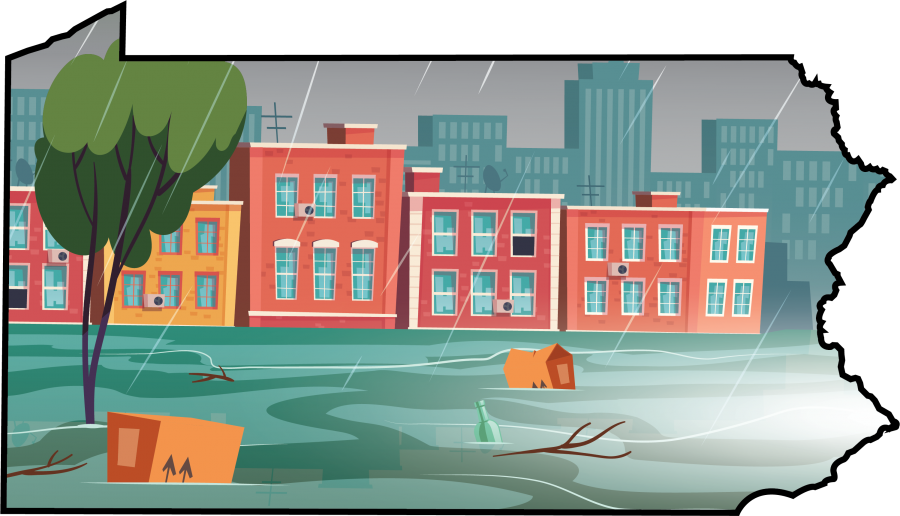
Are you a homeowner or a business owner in Allegheny County? Have you been asking yourself: Why is my basement flooding? Why is the street flooding? What do I do in a flood? How do I protect my house? When do I evacuate?
Watch this free Flood Education Webinar Series to learn about the basics of why it floods, ways to prepare and protect your loved ones and property, and how to recover from a flood.
PWSA joined federal, state, and local partners, including the U.S. Army Corps of Engineers (USACE) and the Allegheny County Conservation District, to present and record this 5-part webinar series during summer 2021. Additional resources are available on the USACE Pennsylvania Silver Jackets website.
Turn Around, Don't Drown!
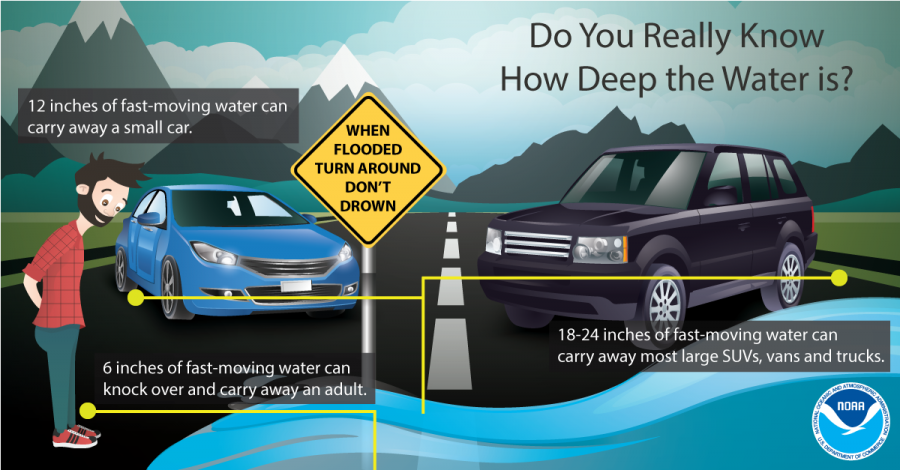
More than half of the deaths from flooding each year occur in vehicles. The next highest percentage of flood-related deaths is due to walking into or near floodwaters. Don't underestimate the power of water.
- 6 inches of fast-moving water can knock over and carry away an adult.
- 12 inches of fast-moving water can carry away a car.
- 18-24 inches of fast-moving water can carry most larger SUVs, vans, and trucks.
However, it is impossible to know how deep the floodwater is just by looking at it. Even a small amount of floodwater can hide dangers such as road collapse and debris. Remember, if you come across floodwaters, Turn Around, Don’t Drown!
